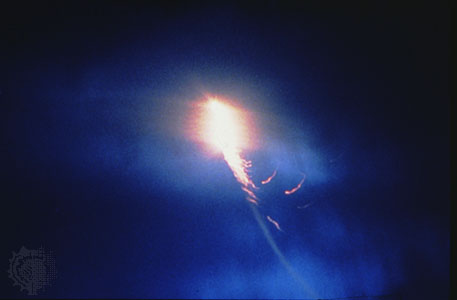What is it?
It's ball lightning!
Before you can take out your phone and snap a few pics of the rare electrical phenomenon, you should probably learn a few things about ball lightning.
1. What is ball lightning?
Well it sounds like what it is! Ball lighting is an unexplained electrical phenomenon that forms naturally during a thunderstorm. Like its name, it consists of lighting in the form of a mobile spherical shape that can float, bounce, travel though walls and buildings in erratic, unpredictable patterns and velocities. Ball lightning comes in the form of various shapes, sizes, and colors. The size of this electric phenomenon can range from 10 to 20 centimeters but can only last less than 10 seconds before frizzling and disappearing or exploding in extreme cases (Barry).
2. How is it formed?

There are many theories speculating on the formation of ball lighting since there is little quantitative data. In past incidents, most witnesses claim that they saw the electrical phenomenon during a thunderstorm after a hot day (Stenhoff). Also in the most recent experiment, researchers have attempted to recreate ball lighting by striking soil with lightning. From the experiment, it seems that ball lighting appears when lighting hits the silicon, silicon monoxide, or silicon carbide, which can all be found in soil. By doing so, they were able to produce a luminous ball for a millisecond before completely disappearing (Choi).
3. Does it actually exist?
Of course it does! Ball lightning has been around for a very long time, dating back to the Somerset Incident in 1596, which was the first sighting of the electrical phenomenon. The witness was in a church when he caught sight of the object floating through the building in the middle of a thunderstorm. The object bounced of off the ceiling and walls a few times before silently disappearing. Since then, there has been multiple sightings of the phenomenon up to the present date (Harrison).
The most recent sighting of ball lighting was in 2014, when two scientists from China performed the experiment in effort to recreate ball lightning in a science laboratory. The scientists recorded a video of the experiment that created a natural ball lightning that lasted only for a few seconds. From the experiment, because traces of elements found in soil were detected from the ball lightning, scientists developed a theory suggesting that ball lightning is formed when soil is struck by lightning (Choi).
4. Is it dangerous?

Based off of the witness accounts, in many cases, ball lightning appears to be harmless, floating through the air before disappearing in seconds. However, there are a few extreme cases in which the ball lightning can be dangerous. During the Great Thunderstorm of Widecome-in-the-Moor in 1638, a ball lighting was formed during a thunderstorm and floated towards a church. Upon entering the church, the object exploded, destroying the entire church, killing four people while injuring sixty others (J. Brooking Rowe).
It is important to understand the dangers of ball lightning. Energy emitted from ball lightning can be extremely powerful and pose a threat to air planes, trees, buildings, animals, and to us.
5. Why is it important for us to know?

While there has been many theories and research devoted to ball lighting, we still do not know much about the phenomenon. In some cases, as described by witnesses, ball lighting appears to be harmless while other times ball lighting can explode before disappearing (Stenhoff). Ball lightning has the potential to be harmful to humans and other animals. Therefore, it is important to be aware of the phenomenon and take safety precaution if one were to form in front of you.
6. What can we do with the information?

Based on previous experiments, many scientists believe that ball lightning is a floating mass of energy since it is composed of lighting in the shape of a glowing sphere. Because it is thought to be composed of lighting, many scientists believe that ball lighting contains a concentrated source of energy (Stenhoff). By knowing more information about the phenomenon, ball lightning can potentially become a possible resource. If scientists can develop a way to harness the energy from ball lightning, it can become a new source of natural energy, and scientists may be able to come up with solutions to other unknowns of the universe.
Barry, J. Dale. “Ball Lightning.” Journal of Atmospheric and Terrestrial Physics. Vol. 29. Ed. R.J. Strangeway and D.
Pancheva. Northern Ireland: Pergamon Press Ltd, 1967. Pp. 1095-1101. Print.
Choi, Charles Q. “Strange Ball Lightning Caught On High Speed on High-Speed Video.” LiveScience. Purch, 21 Jan.
2014. Web. 4 Oct. 2014.
Choi, Charles Q. “Strange Ball Lightning Caught On High Speed on High-Speed Video.” LiveScience. Purch, 21 Jan.
2014. Web. 4 Oct. 2014.
Harrison, Prof. G. B. (21 April 1976). "Letters to the editor: Ball lightning". The Times (Times Newspapers Limited).
J. Brooking Rowe, ed. (1905). The Two Widecombe Tracts, 1638, giving a Contemporary Account of the great Storm,
Stenhoff, Mark. Ball Lightning: An Unsolved Problem in Atmospheric Physics. New York: Kluwer Academic / Plenum,
1999. Print.

